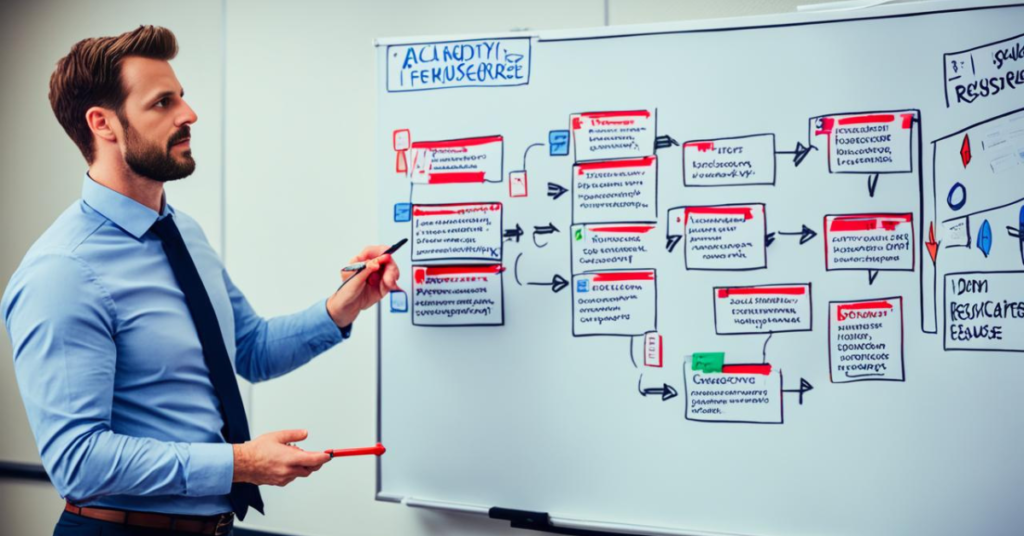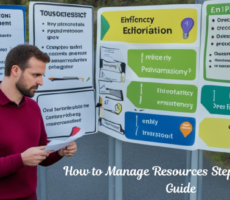How to Manage Resources Step-by-Step: A Guide
Resource management is very important when implementing projects. This guide will explain how to efficiently use your resources and discover how to manage them to achieve your project objectives.
Managing a team or assets requires a step-by-step plan. First, this approach gives you the tools and insights for resource management. As a result, you can make smart choices and keep your project on track by matching your resource needs with what you have.
Explore resource allocation strategies and learn how to plan your project better. Furthermore, you’ll find ways to improve your workflows while using resources entirely. Ultimately, get ready to boost your project management skills.
Effective Resource Management: A Holistic Approach
Managing resources well means having a complete plan that looks at forecasting, allocating, and optimizing. By doing so, companies can accurately guess what they’ll need in the future, identify the most critical projects, and efficiently use resources wisely.
Also Read: Choosing Features in a Resource Management Tool
Resource Forecasting: Anticipating Future Needs
Getting resource forecasting right is critical to managing resources well. By using different resource forecasting methods, companies can guess what they’ll need later. This helps avoid delays, makes projects succeed, and lets teams adjust to new business needs.
Resource Allocation Strategies: Prioritizing and Optimizing
After forecasting resource needs, it’s time to plan how to use them. This means picking the most important projects, spreading out workloads, and making the most of resources. By matching what help are available with what projects need, companies can work better, save money, and deliver outstanding results.

Monitoring how resources are being utilized is very important in resource management. It is thus possible for companies to facilitate the observation of how aids are used and where things slow down and then make necessary changes so that resources are effectively utilized.
How to Manage Resources Step-by-Step
Managing resources well is critical to any organization’s success. Firstly, it means matching what you have with what you need. Additionally, it involves monitoring how you use these aid. By doing this, you can work more efficiently and increase your profitability. Now, let’s examine resource management step by step.
Resource Capacity Planning: Aligning Requirements and Availability
First, you need to check how much you can do. Look at your team, tools, and other assets. Then, match them with what your projects need. This helps you use your resources well so your team can do great work on time and within budget.
Read: How to Apply Advanced Resource Management Techniques
Here are some tips for planning your resources:
- Analyze project requirements: Consider what skills and resources you need for your projects.
- Inventory your resources: List what you have, like people and equipment, and what they can do.
- Match resources to requirements: Put your resources where they fit best to meet project needs.
- Identify resource gaps: Determine what you’re missing and plan to fill them, such as hiring or outsourcing.
Resource Tracking and Monitoring: Ensuring Efficient Utilization
After planning, track and monitor your resources. This means watching how you use them, finding ways to do better, and changing things to use them better.
Here are some ways to track and monitor resources:
- Establish resource utilization metrics: Create numbers to show how well you use your resources, such as hours worked or projects finished.
- Implement resource tracking tools: Use software or tools to see where your resources are and how they’re being used.
- Analyze resource data: Examine the data to find patterns, problems, and opportunities to use resources more effectively.
- Adjust resource allocation: Change how you use your resources based on what you learn to use them better.
By following these steps for planning and tracking resources, you can use your resources well, which will lead to your organization’s success.

Read Also: How to Implement a Resource Management System: A Step-by-Step Guide
Conclusion
This guide has given you a detailed look at managing resources. Consequently, you now know how to make your projects more efficient, reduce waste, and get more from your resources. It covered everything from forecasting resources to tracking them closely.
By taking a comprehensive view of resource management, you can clearly see what you’ll need in the future and consequently focus on the most critical tasks. In this manner, you can effectively utilize your resources. Furthermore, keeping a close eye on your aids helps you manage the challenges associated with them.
This guide aims to make your work smoother, save you money, and help your projects succeed. It’s useful for both experienced and new project managers. It gives you the tools and strategies to excel in optimizing resources.
Read: Mastering Resource Management Software: A Guide to Effective Usage
